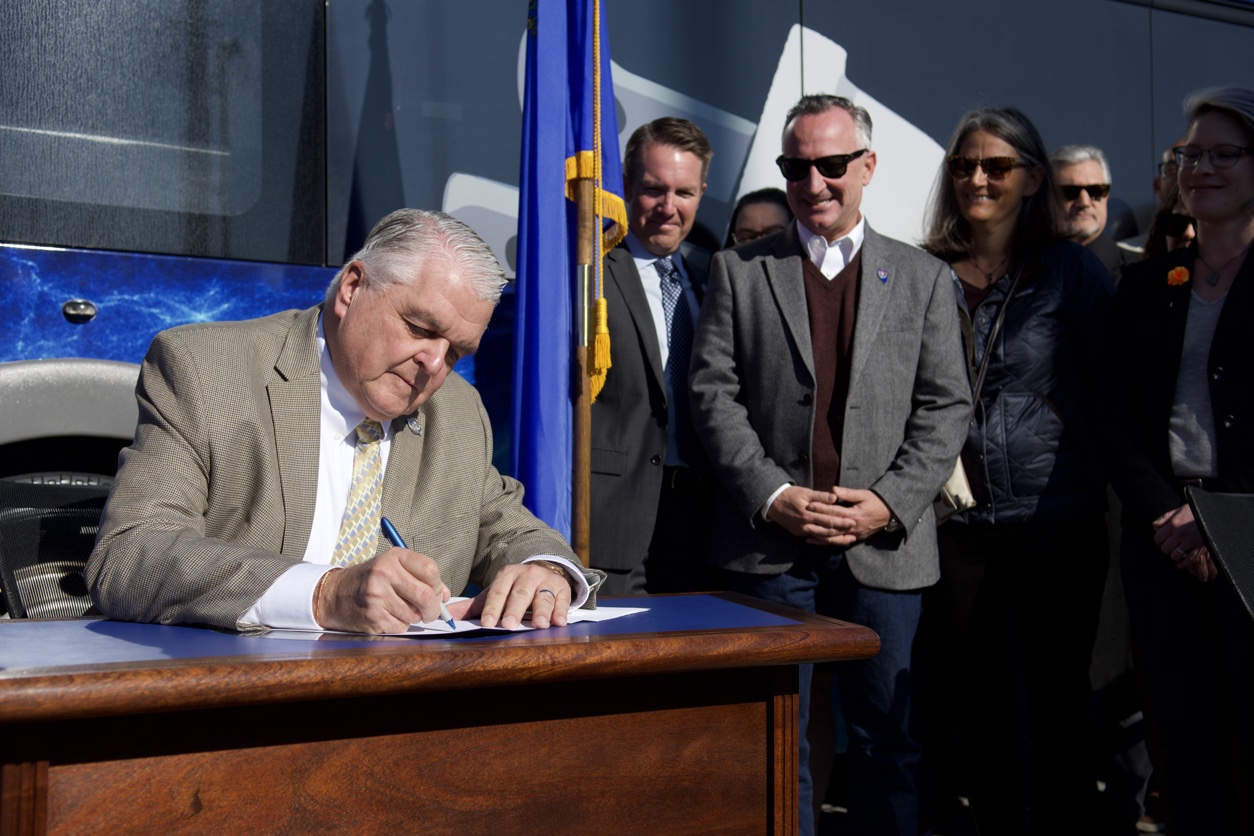IndyMatters: How Sisolak’s climate change executive order will be implemented

Flanked by a small crowd of smiling lawmakers and state workers, Gov. Steve Sisolak last month sat down in front of an electric bus in Reno to sign an executive order directing his administration to take a serious look at climate change.
Signing the executive order was the most recent step for Sisolak — the state’s first Democratic governor in 20 years — in aligning Nevada with national and worldwide efforts to combat the effects of climate change, including signing up the state in March to meet the emission reduction targets as part of the U.S. Climate Alliance.
But beyond the rhetoric — which includes an oft-repeated Sisolak promise to “not spend a single second debating the reality of climate change” — what does the executive order actually do, and how will it affect the state and the lives of Nevadans?
Two of the individuals responsible for answering that question are Brad Crowell, director of the state’s Department of Conservation and Natural Resources, and David Bobzien, director of the Governor’s Office of Energy, both of whom were tasked to carry out many of the requirements in the executive order.
Both sat down for an interview on the Indymatters podcast in late November to discuss the executive order, how it differs from a 2019 bill requiring more frequent emissions reporting and the potential suggestions and policy changes to reduce carbon emissions that may end up before the 2021 Legislature.
“This executive order was a great way to put all of those things together and provide the platform, in many ways, for a lot of the work and the coordination that the administration was already doing,” Bobzien said. “But if anything this executive order makes it clear that the governor values this work and wants to see us make progress on it.”
The actual text of the executive order largely reiterates but also adds a few wrinkles and new requirements to a law passed in the 2019 Legislature, SB254, which increases the frequency of a mandated report on the state’s emissions and requires the agency to identify potential solutions and policies that would help meet emission reduction goals. Carbon emission reduction goals, which use 2005 as a baseline, call for targets of a 28 percent reduction by 2025 and 45 percent by 2030, with an aspirational goal of zero or near-zero emissions by 2050.
But as he indicated during an interim legislative meeting last month, Crowell said the forthcoming report (required to be released before the end of the year) will say that highly-touted measures to increase Nevada’s Renewable Portfolio Standard to 50 percent by 2030 will likely not be enough to hit the targeted emission reduction goals set by the state.
“We're going to have to have some more revolutionary and innovative changes in decarbonizing our economy to reach that 2030 goal,” he said.
Both Bobzien and Crowell said one of the most likely targets for future emission reduction policies will come in the transportation sector, which is projected to become the state’s largest net emitter of greenhouse gasses. Although Nevada has not adopted California’s tougher rules on fuel economy standards for cars and trucks, the state did join onto a lawsuit led by its western neighbor to stop the Trump administration from revoking its ability to set higher emission standards than the federal level, and Crowell said the state was keeping a close eye on the outcome of the litigation.
“Right now we don't have a set regulatory pathway, but we're going to be analyzing what has been done in other states and determining what is best for Nevada,” Crowell said. “I will say that when you look at vehicle emissions writ large in Nevada, the heavy-duty vehicle sector outweighs the passenger vehicle sector pretty significantly.”
Bobzien said the state was already taking on one proactive measure to reduce transportation sector emissions by building out electric vehicle infrastructure, primarily through the program launched in 2015 known as the Nevada Electric Highway, which provides electric vehicle charging stations in rural communities around the state. Other suggested policy ideas may come from partnering with the state’s Department of Transportation (required in the executive order) to cut down on vehicle miles traveled as well as alternative transportation methods.
“It's fair to say that as we continue down this road of refining the modeling and understanding exactly what the data is showing us when it comes to the emissions, we'll be able to in the future pair that with more specific policy ideas for how to deal with those different aspects of the emissions,” Bobzien said.
Although the executive order requires the administration to produce a “State Climate Strategy” by December 2020, Crowell and Bobzien said they were still determining the process forward to develop that strategy over the next year, but indicated it would likely involve public meetings as well as input from local and tribal governments.
“There's just absolutely no way to do what we've set out for ourselves in the data without robust stakeholder engagement and a new level of collaboration among executive branch agencies,” Crowell said.
